
French cuisine is the cooking traditions and practices from France. In the 14th century, Guillaume Tirel, a court chef known as "Taillevent", wrote Le Viandier, one of the earliest recipe collections of medieval France. In the 17th century, chefs François Pierre La Varenne and Marie-Antoine Carême spearheaded movements that shifted French cooking away from its foreign influences and developed France's own indigenous style.

In cooking, a sauce is a liquid, cream, or semi-solid food, served on or used in preparing other foods. Most sauces are not normally consumed by themselves; they add flavor, moisture, and visual appeal to a dish. Sauce is a French word taken from the Latin salsa, meaning salted. Possibly the oldest recorded European sauce is garum, the fish sauce used by the Ancient Romans, while doubanjiang, the Chinese soy bean paste is mentioned in Rites of Zhou in the 3rd century BC.
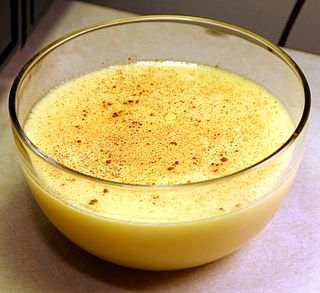
Custard is a variety of culinary preparations based on sweetened milk, cheese, or cream cooked with egg or egg yolk to thicken it, and sometimes also flour, corn starch, or gelatin. Depending on the recipe, custard may vary in consistency from a thin pouring sauce to the thick pastry cream used to fill éclairs. The most common custards are used in custard desserts or dessert sauces and typically include sugar and vanilla; however, savory custards are also found, e.g., in quiche.

An omelette is a dish made from eggs, fried with butter or oil in a frying pan. It is a common practice for the omelette to be folded around fillings such as chives, vegetables, mushrooms, meat, cheese, onions or some combination of the above. Whole eggs or egg whites are often beaten with a small amount of milk, cream, or water.
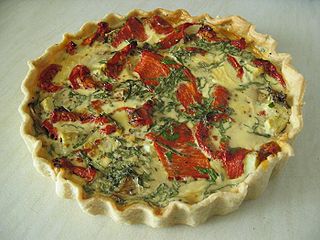
Quiche is a French tart consisting of pastry crust filled with savoury custard and pieces of cheese, meat, seafood or vegetables. A well-known variant is quiche Lorraine, which includes lardons or bacon. Quiche may be served hot, warm or cold.
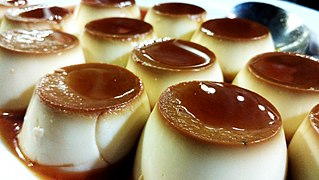
Crème caramel, flan, caramel pudding, condensed milk pudding or caramel custard is a custard dessert with a layer of clear caramel sauce.

Pierogi or Pierogies are filled dumplings, made by wrapping unleavened dough around a filling, and occasionally flavored with a savory or sweet garnish and cooked in boiling water.

Scrambled eggs is a dish made from eggs stirred, whipped, or beaten together typically with salt, butter, oil, and sometimes other ingredients, and heated so that they form into curds.
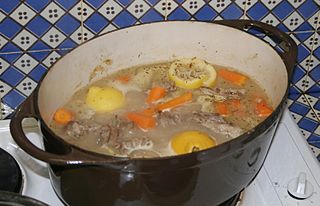
Blanquette de veau is a French veal stew. In the classic version of the dish the meat is simmered in a white stock and served in a sauce velouté enriched with cream and egg. It is among the most popular meat dishes in France.

Pâté is a forcemeat. Originally, the dish was cooked in a pastry case; in more recent times it is more usually cooked without pastry in a terrine. Various ingredients are used, which may include meat from pork, poultry, fish or beef; fat, vegetables, herbs, spices, wine and brandy.

The bacon and egg pie is a savoury pie consisting of a crust containing bacon, egg and sometimes onion, mushrooms, bell peppers, peas, tomato, fresh herbs and cheese. It is popular in New Zealand. However, bacon and egg pie originated during the Middle Ages in Cornwall and is still a popular pie cooked in Cornish homes today. Bacon and egg pie may be served with ketchup, which can be combined with Worcestershire sauce and drizzled over the filling before the pie is baked and some versions have a rising agent such as baking powder mixed into the egg to make a fluffier filling.
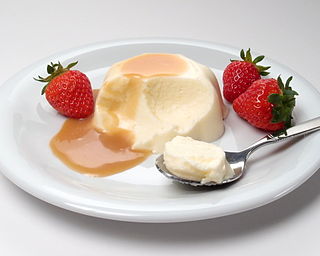
Bavarian cream, crème bavaroise or simply bavarois is a French dessert consisting of an egg-based cooked custard and gelatin or isinglass, into which whipped cream is folded. The mixture sets up in a cold mold and is unmolded for serving. Earlier versions, sometimes called fromage bavarois, did not include eggs or any actual cheese. One recipe using isinglass also calls for crumbled amaretto cookies, chocolate and other flavorings. One contemporary French recipe for "bavarois" is a savory preparation with a neufchâtel-type cheese and leeks, and is not a sweet dessert.

Duchess potatoes consist of a purée of mashed potato, egg yolk, and butter, which is forced from a piping bag or hand-moulded into various shapes which are then baked in a high temperature oven until golden. They are typically seasoned similarly to mashed potatoes with, for example, salt, pepper, and nutmeg. They are a classic item of French cuisine, and are found in historic French cookbooks.

Navarin is a French ragoût (stew) of lamb or mutton. If made with lamb and vegetables available fresh in the spring, it is called navarin printanier. The dish was familiar in French cookery well before it acquired the name "navarin" in the mid-19th century; there are several theories about the origin of the current name.

Chicken chasseur is a French dish, known in France as poulet chasseur, poulet à la chasseur or poulet sauté chasseur). It consists of fried chicken served hot, with sauce chasseur, which is based on mushrooms, onions or shallots, tomatoes and wine and may also contain stock and various herbs. The name derives from the French chasseur, meaning "hunter".

Florentine or à la Florentine is a term from classic French cuisine that refers to dishes that typically include a base of cooked spinach, a protein component and Mornay sauce. Chicken Florentine is the most popular version. Because Mornay sauce is a derivation of béchamel sauce which includes roux and requires time and skill to prepare correctly, many contemporary recipes use simpler cream-based sauces.

The coronation quiche was chosen by King Charles III and Queen Camilla as the signature dish of their coronation celebrations in May 2023.


















